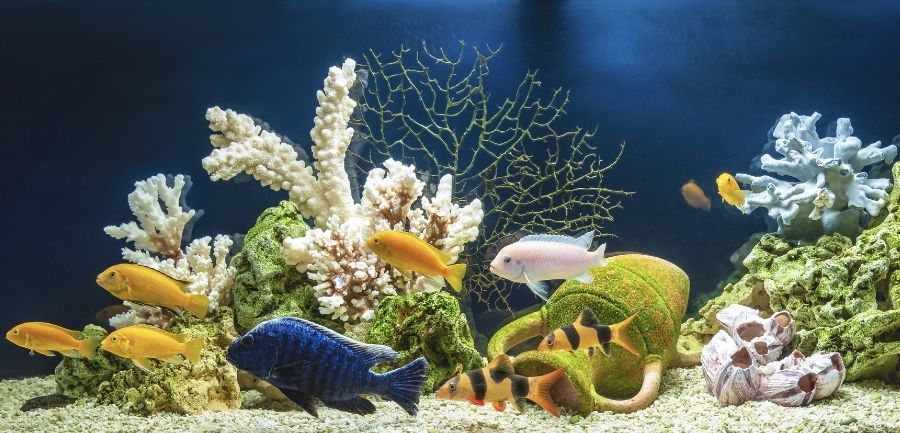
7 Common Diseases in Freshwater Aquarium Fish

You go to a lot of expense and trouble to set up a beautiful aquarium and to choose fish you’ll enjoy watching swim around in it. It can be heartbreaking to see them begin to fail, sicken, or even die. Watch out for these seven common diseases in freshwater aquarium fish.
Things That Can Make Fish Sick
When aquarium fish are stressed, their immune systems can weaken. They become susceptible to fungal, bacterial, and viral infections. Parasites can invade their systems. A poorly-maintained aquarium can harbor toxins, pollutants, chemicals, and pharmaceutical remnants in the water. Any of these things can affect piscine immune systems and cause fish to become ill. Poor diets and overcrowding in the aquarium can also make fish sick.
Introducing new fish that haven’t been properly quarantined can also bring disease into the environment.
Parasitic Diseases
“Ich”
Pronounced “ick,” (and that’s exactly what you might say if you find small white bumps all over your fish) this parasitic infection is common in aquariums. In addition to the white bumps, other symptoms include twitching, darting around, or rubbing against gravel or aquarium decorations.
Ich (short for ichthyopthirius multifiliis) can lurk in your aquarium, and resident fish can become resistant to it. But when you add new fish that are stressed, they can come down with it.
Ich can also be the result of sudden temperature changes in the aquarium when you add cold water, or your heater malfunctions.
Treatments can include medication, or slowly raising the temperature of the aquarium to 86° and keeping it there for two weeks, speeding the lifecycle of the parasites and causing them to die off.
Rust or Gold Dust Disease
Sometimes called “velvet” disease, a parasite called oodinium causes this disease. An infected fish’s skin may turn yellowish or begin to peel off; they may fold their fins close to their bodies, breathe quickly, or as in Ich, rub against surfaces in the aquarium.
Oodinium infection can be caused by poor water maintenance, or the introduction of infected plants or new fish. It’s highly contagious, and unfortunately, by the time symptoms appear, it may be too late. There are treatments for it, but the best course is prevention.
Hole in the Head or Line Disease
Caused by a protozoan parasite called Hexamita, you’ll recognize this disease by sunken spots or cavities in the fish’s head and along its flanks. The fish may become lethargic, stop eating, or its coloration may fade. Changing the water, removing carbon filters, and giving any affected fish medicated food are all possible solutions.
Bacterial Infections
Columnaris
This is a bacterial infection that is often confused with a similar-looking fungal infection. Both may be referred to as Cotton Mouth. The fish may present with ragged, frayed fins, ulcerations or moldy-looking patches on the skin, or changes in fin color to white or brown. It can be caused by overcrowding, bad water quality, or a shifting pH. Some antibiotic treatments may help, or, if your freshwater fish can tolerate it, adding aquarium salt to just above a 1% solution will kill the bacteria.
Dropsy
When afflicted by this condition, fish start to look bloated, their eyes may bulge, and their scales stick out. Dropsy is a bacterial infection typically caused by Aeromonas, a bacterium common in most fish tanks. It is often fatal if not caught early and can arise from overcrowding and stress.
Fin Rot
This disease looks like it sounds: your fish’s fins seem to be rotting away. Although this is caused by a variety of bacteria, the tank’s environment could be at the root of the problem. Fish that are stressed by bullying in the tank, overcrowding, dirty filters, and elevated levels of ammonia or nitrates could all be culprits. Clean the aquarium (including gravel), change half the water, and remove bullies. Some antibiotic treatments may also be available to treat fin rot.
Viral Diseases
Lymphocystis
Viral diseases can be difficult to diagnose in fish, but a common one is Lymphocystis. It’s the most common viral infection and can come into your tank through infected food or infected fish. Your fish may have difficulty swimming and may display small, cauliflower-like growths on their bodies.
While there is no treatment for Lymphocystis, the disease usually resolves by itself. It’s important to maintain optimal tank conditions and watch out for secondary effects, like infections.
The Importance of Tank Environment
A common thread running through the causes and cures of these common diseases in freshwater aquarium fish is the quality of the environment in the tank. Attention to temperature, ammonia, nitrite and nitrate levels, and especially to the careful introduction of new fish or plants, is critical to maintaining the health of your fish.
For example, you should buy fish online from a reputable supplier who will explain how they quarantine and ship fish. Be prepared with a quarantine tank before you introduce new fish. This gives fish a chance to recover from the stress of shipment and ease into their new life with you.
Things You Need for a Healthy Tank
Keeping a freshwater aquarium healthy involves selecting compatible fish, beneficial live plants, and the proper type of filtering and aeration. You’ll also need to consider lighting and substrate, which may include sand and or gravel, to support your aquarium plants.
Tap water contains chlorine. Untreated and unfiltered well or pond water can contain chemical, agricultural, pharmaceutical, or petrochemical pollutants. A healthy freshwater aquarium demands a clean water source and the right kind of water conditioner to ensure the proper balance of elements in your tank.
Find a reliable supplier who can educate you about the types of equipment and additives you may need to keep your selection of fish healthy. Forge a relationship with your local city aquarium, which can be a source of expertise about exotic fish species. Finally, be sure you have the services of a knowledgeable veterinarian who understands common diseases in freshwater aquarium fish, how to prevent them, and how to treat them if your fish become infected.
With proper attention, the right equipment, and the optimal combination of healthy fish and live aquarium plants, you can look forward to observing your fish as they swim around for years to come.

